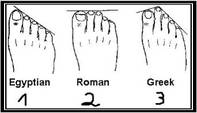
Morton’s Toe: One Little Bone, One Big Problem
by Linda Fehrs, LMT
The human body contains many wonderful things. Most of them have been handed down genetically, from parent to child, and there is little we can do to change them. One such trait is called Morton’s Toe. Only about 10 percent of the world population has this attribute, where the second toe appears longer than the first. About 80 percent of those with Morton’s Toe suffer from chronic pain. Much of it is thought to derive from this relatively rare foot configuration. Learn how discomfort from Morton’s Toe can be eased using massage therapy.
The human body is indeed a marvelous, well-coordinated system of bones, muscles, organs, glands and a myriad of other wonders. Most of the time, for many people, it works just the way it is supposed to. Our bodies allow us to move about – forward, backward and sideways. Possible infections are thwarted, nourishment is supplied to all regions, toxins are removed and so on and so on. Such a perfect machine cannot be built by man or woman. But even human beings are not absolute in their perfection. Each of us, or should I say most of us, have some small anomaly, a trait or traits that make us unique. We do not all look alike, talk alike or walk alike – except within a certain universal parameter.
While doing research on another article, I discovered something about myself, that for more than 50 years I had always thought to be normal – only now to find out that by some it is labeled a “deformity.” It is referred to as Morton’s Toe (also called Morton’s Syndrome), so named after Dr. Dudley J. Morton, a physician, orthopedic surgeon, researcher and author who was well-known in the 1920s through the1950s. He described this condition, in which the second toe appears to be longer that the first or “big” toe.
What Is Morton’s Toe?
If you were to look at a normal foot, according to experts, you would see that the first toe is usually the longest as well as the largest. The remaining toes are shorter and smaller, going down proportionately in size. With a foot exhibiting Morton’s Toe, the first toe may be either equal in length or somewhat shorter than the second toe. In actuality, the cause of this is not that the second toe is longer than the first, as much as the first metatarsal is shorter than it should be in relation to the second metatarsal. It is estimated that only about 10 percent* of the world’s population has this configuration of bones in the feet.
Morton’s Toe is not to be confused with Morton’s Neuroma, a condition named for Thomas C. Morton, which is a painful condition of entrapped nerves found in the intermetatarsal spaces of the foot (in acupressure points it would be located in the proximity of Kidney 1), and thought to be caused by the wearing of shoes that are too tight or too narrow. Morton’s Toe is genetic, while Morton’s Neuroma is acquired. In some cases, the neuroma can be caused by Morton’s Toe.
A foot with a long second toe is unofficially known as the Classic Greek Foot and those who share this distinction share it as well with the Statue of Liberty (also known as Liberty Enlightening the World) created by the artist and sculptor Frédéric Auguste Bartholdi.
A Cause of Many Ills
Dr. Dudley Morton wrote many articles on the repercussions of having a long second toe; among many other ailments, he claimed the following were a result of this podiatric phenomenon:
Dr. Morton isn’t the only person to recognize the connection of this condition to the rest of the body. Dr. Janet Travell also wrote extensively on this structural oddity. Travell was a personal physician to both Presidents Kennedy and Johnson, as well as their families. She was also the person who developed Trigger Point Therapy and imparted a new understanding of myofascial pain syndrome. One full tape of her seven-set series is dedicated to the single subject of Morton’s Toe.
Dr. Burton S. Schuller has written an entire book, Why You Hurt: It All Starts in the Foot, about Morton’s Toe and the associated ailments. He and the others claim that if the foot has this structure, by connection to the rest of the body, there is a resulting chain reaction of misalignment causing all kinds of problems.
A Simple Solution
Morton’s Toe and many other foot problems are genetic. They are handed down as an unintended gift from generation to generation, just like the natural color of your hair or eyes. There is no cure, though some sufferers have tried rather drastic surgery to alleviate the chronic pain.
There is, however, a rather simple remedy consisting of making a small foot pad approximately the diameter and depth of a quarter or half dollar coin. The foot pad can be made by cutting the shape out of an insole, which can be purchased at any drug store. This is then taped to the base of the toe at the head of the first metatarsal bone. With some creativity you can make a more permanent solution with a full insole and a patch.
Massage Helps Ease the Pain
Clients often arrive at a massage office with non-specific complaints of chronic pain. It is not unlikely that these long time sufferers have heard of all kinds of reasons for their pain, and applied all kinds of remedies over the years. One look at his or her feet will tell you if the person has Morton’s Toes.** Aside from the solution above, massage therapy can do a great deal to ease the possibly related pain.
What is most often recommended is Trigger Point Therapy, although Swedish massage, acupressure, neuromuscular techniques and reflexology will help as well. The most common trigger points related to Morton’s Toe are:
While doing research on another article, I discovered something about myself, that for more than 50 years I had always thought to be normal – only now to find out that by some it is labeled a “deformity.” It is referred to as Morton’s Toe (also called Morton’s Syndrome), so named after Dr. Dudley J. Morton, a physician, orthopedic surgeon, researcher and author who was well-known in the 1920s through the1950s. He described this condition, in which the second toe appears to be longer that the first or “big” toe.
What Is Morton’s Toe?
If you were to look at a normal foot, according to experts, you would see that the first toe is usually the longest as well as the largest. The remaining toes are shorter and smaller, going down proportionately in size. With a foot exhibiting Morton’s Toe, the first toe may be either equal in length or somewhat shorter than the second toe. In actuality, the cause of this is not that the second toe is longer than the first, as much as the first metatarsal is shorter than it should be in relation to the second metatarsal. It is estimated that only about 10 percent* of the world’s population has this configuration of bones in the feet.
Morton’s Toe is not to be confused with Morton’s Neuroma, a condition named for Thomas C. Morton, which is a painful condition of entrapped nerves found in the intermetatarsal spaces of the foot (in acupressure points it would be located in the proximity of Kidney 1), and thought to be caused by the wearing of shoes that are too tight or too narrow. Morton’s Toe is genetic, while Morton’s Neuroma is acquired. In some cases, the neuroma can be caused by Morton’s Toe.
A foot with a long second toe is unofficially known as the Classic Greek Foot and those who share this distinction share it as well with the Statue of Liberty (also known as Liberty Enlightening the World) created by the artist and sculptor Frédéric Auguste Bartholdi.
A Cause of Many Ills
Dr. Dudley Morton wrote many articles on the repercussions of having a long second toe; among many other ailments, he claimed the following were a result of this podiatric phenomenon:
- Back pain
- Hip pain
- Knee pain
- Arthritis
- Fibromyalgia
- Bunions and hammer toes
- Temporomandibular joint pain
Dr. Morton isn’t the only person to recognize the connection of this condition to the rest of the body. Dr. Janet Travell also wrote extensively on this structural oddity. Travell was a personal physician to both Presidents Kennedy and Johnson, as well as their families. She was also the person who developed Trigger Point Therapy and imparted a new understanding of myofascial pain syndrome. One full tape of her seven-set series is dedicated to the single subject of Morton’s Toe.
Dr. Burton S. Schuller has written an entire book, Why You Hurt: It All Starts in the Foot, about Morton’s Toe and the associated ailments. He and the others claim that if the foot has this structure, by connection to the rest of the body, there is a resulting chain reaction of misalignment causing all kinds of problems.
A Simple Solution
Morton’s Toe and many other foot problems are genetic. They are handed down as an unintended gift from generation to generation, just like the natural color of your hair or eyes. There is no cure, though some sufferers have tried rather drastic surgery to alleviate the chronic pain.
There is, however, a rather simple remedy consisting of making a small foot pad approximately the diameter and depth of a quarter or half dollar coin. The foot pad can be made by cutting the shape out of an insole, which can be purchased at any drug store. This is then taped to the base of the toe at the head of the first metatarsal bone. With some creativity you can make a more permanent solution with a full insole and a patch.
Massage Helps Ease the Pain
Clients often arrive at a massage office with non-specific complaints of chronic pain. It is not unlikely that these long time sufferers have heard of all kinds of reasons for their pain, and applied all kinds of remedies over the years. One look at his or her feet will tell you if the person has Morton’s Toes.** Aside from the solution above, massage therapy can do a great deal to ease the possibly related pain.
What is most often recommended is Trigger Point Therapy, although Swedish massage, acupressure, neuromuscular techniques and reflexology will help as well. The most common trigger points related to Morton’s Toe are:
- Gluteus Medius
- Tensor Fasciae Latae
- Quadriceps
- Peroneus Longus
- Tibialis Posterior
- Adductor Longus
- Flexor Hallucis Brevis
Story Source:
For a full article click here. © 2013 Institute for Integrative Healthcare Studies. This work is reproduced with the permission of the Institute. www.Integrative-Healthcare.org
Disclaimer: All article posted on this website are not intended to provide medical advice, diagnosis or treatment.
Investing in massage is an investment in your health.
Take advantage of this months specials we offer
& book your appointment today!
Call 623-399-7595
Take advantage of this months specials we offer
& book your appointment today!
Call 623-399-7595



 RSS Feed
RSS Feed
